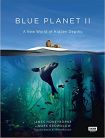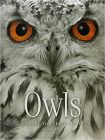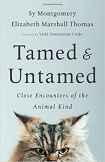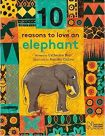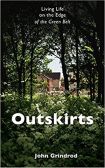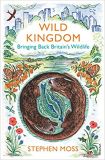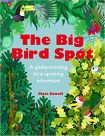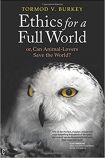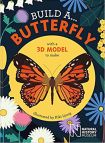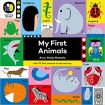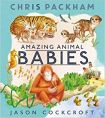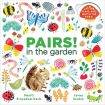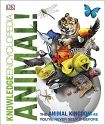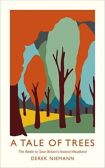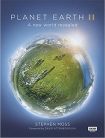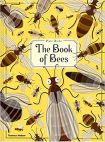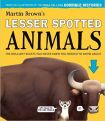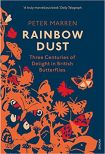Difference between revisions of "Newest Animals and Wildlife Reviews"
| Line 11: | Line 11: | ||
You may well remember when the sticking of a number '2' after a film title was suggesting something of prestige - that the first film had been so good it was fully justified to have something more. That has hardly been proven correct, but it has until recently almost been confined to cinema - you barely got a TV series worthy of a numbered sequel, and never in the world of non-fiction. If someone has made a nature series about, say, Alaska (and boy aren't there are a lot of those these days) and wants to make another, why she just makes another - nothing would justify the numeral. But some nature programmes do have the prestige, the energy and the heft to demand follow ups. And after five years in the making, the BBC's Blue Planet series has delivered a second helping. [[Blue Planet II by James Honeyborne and Mark Brownlow|Full Review]] | You may well remember when the sticking of a number '2' after a film title was suggesting something of prestige - that the first film had been so good it was fully justified to have something more. That has hardly been proven correct, but it has until recently almost been confined to cinema - you barely got a TV series worthy of a numbered sequel, and never in the world of non-fiction. If someone has made a nature series about, say, Alaska (and boy aren't there are a lot of those these days) and wants to make another, why she just makes another - nothing would justify the numeral. But some nature programmes do have the prestige, the energy and the heft to demand follow ups. And after five years in the making, the BBC's Blue Planet series has delivered a second helping. [[Blue Planet II by James Honeyborne and Mark Brownlow|Full Review]] | ||
<br> | <br> | ||
| + | <hr/> | ||
<!-- Taylor --> | <!-- Taylor --> | ||
Revision as of 13:23, 23 January 2018
Blue Planet II by James Honeyborne and Mark Brownlow
![]() Animals and Wildlife, Popular Science
Animals and Wildlife, Popular Science
You may well remember when the sticking of a number '2' after a film title was suggesting something of prestige - that the first film had been so good it was fully justified to have something more. That has hardly been proven correct, but it has until recently almost been confined to cinema - you barely got a TV series worthy of a numbered sequel, and never in the world of non-fiction. If someone has made a nature series about, say, Alaska (and boy aren't there are a lot of those these days) and wants to make another, why she just makes another - nothing would justify the numeral. But some nature programmes do have the prestige, the energy and the heft to demand follow ups. And after five years in the making, the BBC's Blue Planet series has delivered a second helping. Full Review
Owls: A Guide to Every Species by Marianne Taylor
![]() Reference, Animals and Wildlife
Reference, Animals and Wildlife
I feel like I am being watched. A huge pair of piercing orange eyes are staring right at me, locking me into their gaze. In contrast with the hardness of the deep-amber eyes, soft grey feathers fan out into the surrounding area, intricate, detailed and beautiful. An enigma; harsh and gentle at the same time, the owl is beckoning the reader to turn the pages and take a closer look inside... Full Review
Tamed and Untamed: Close Encounters of the Animal Kind by Sy Montgomery and Elizabeth Marshall Thomas
Sy Montgomery and Elizabeth Marshall-Thomas are best friends who also happen to be New York Times best-selling authors. They first bonded over their shared love of animals: shortly after meeting, Sy's pet ferret had given Liz a nasty bite, but Liz didn't seem to mind at all. She REALLY didn't mind being bitten by a weasel. I knew we were soul mates, recalls Sy. Tamed and Untamed is the resulting collaboration between the two friends as they share personal anecdotes and amazing stories about the animal world.
10 Reasons to Love an Elephant by Catherine Barr and Hanako Clulow
![]() Children's Non-Fiction, Animals and Wildlife
Children's Non-Fiction, Animals and Wildlife
Ten reasons to love an elephant, eh? Well, personally, I've never needed ten reasons as they've always been my favourite large animal, the gentle giants of Africa and India, but it was good to find out more about them. Perhaps the most surprising fact which I discovered was that they live in herds headed by their grandmothers. Female elephants and their calves stay together and the oldest female elephant is the one in charge as she knows where to find food and water - and she knows her herd. She remembers about people too. Full Review
Outskirts by John Grindrod
![]() Animals and Wildlife, Autobiography
Animals and Wildlife, Autobiography
Outskirts is an interesting take on a phenomenon of the modern age: the introduction of the green belt of countryside surrounding inner city housing estates. John Grindrod grew up on the edge of one such estate in the 1960's and '70's, as he puts it, I grew up on the last road in London. Grindrod explores the introduction of the green belt, and the various fights and developments it has gone through over the subsequent decades, as environmental and political arguments have affected planning decisions. Within this topic, he has somehow managed to wind around his personal memories of childhood, producing a memoir with a lot of heart. Full Review
Wild Kingdom: Bringing Back Britain's Wildlife by Stephen Moss
Wildlife has been declining in Britain over the last few decades; it is an unfortunate by-product of human population growth, which in the modern world has increased significantly. Through this book Moss suggests a few ways in which we can start to bring back some of Britain's wildlife without compromising the human way of life: we can co-exist with nature. Full Review
The Big Bird Spot by Matt Sewell
![]() Children's Non-Fiction, Animals and Wildlife
Children's Non-Fiction, Animals and Wildlife
Recently I stood on a viewing platform at the RSPB reserve at Bempton Cliffs as a very helpful volunteer guided my sight line to one of the puffins who'd arrived on the cliffs in the last few days. Finally, I found one, after visually sorting through all the other birds on the precipitous cliff face. It was great fun and very rewarding. The third double-page spread in wild-life author and artist Matt Sewell's first book for children, The Big Bird Spot, shows some cliffs very like those at Bempton, but this time you're going to be looking for twenty three Little Auks, in amongst the guillemots, puffins, herring gulls and razorbills. Oh, and you're looking for a pair of binoculars too: our bird watcher is very careless, because you're going to have to find them in every picture. Full Review
Ethics for a Full World or, Can Animal-Lovers Save the World? by Tormod V Burkey
Burkey argues that man's current practices are outside the realms of nature. He is no longer part of the ecosystem, but instead exists above it through his dominating ways. He is himself distanced even further by advancement in technologies, industry, money and all the pollution that comes with them. The natural world, Burkey argues, no longer exists for man because he has altered it by such things. Indeed, global warming has caused climate change, which, if it continues, will make the world unrecognisable. For the world to become fuller, for it to be a world that seeks to provide for the needs of every living thing, then it needs to change. Full Review
Build a ... Butterfly by Kiki Ljung
![]() Children's Non-Fiction, Animals and Wildlife, Crafts
Children's Non-Fiction, Animals and Wildlife, Crafts
I love butterflies: they're one of the delights of my garden and it's always a pleasure when there are children there and they see a butterfly close up, possibly for the first time, as it rests on a flower. Kiki Ljung has given us the opportunity to learn about butterflies and also to build a 3D model of our own. The book is primarily aimed at the five to eight year old age group, but I have to confess that I had a great deal of fun building my own painted lady. I learned quite a bit too! Full Review
Foxes Unearthed: A Story of Love and Loathing in Modern Britain by Lucy Jones
![]() Animals and Wildlife, Popular Science
Animals and Wildlife, Popular Science
As one of the largest predators left in Britain, the fox is captivating: a comfortably familiar figure in our country landscapes; an intriguing flash of bright-eyed wildness in our towns. Yet no other animal attracts such controversy, has provoked more column inches or been so ambiguously woven into our culture over centuries, perceived variously as a beautiful animal, a cunning rogue, a vicious pest and a worthy foe. As well as being the most ubiquitous of wild animals, it is also the least understood. Here Lucy Jones investigates the truth about foxes – delving into fact, fiction, folklore and her own history with the creatures. Discussing the debate on foxes, Jones asks what our attitudes towards foxes says about us, and our relationship with the natural world.Full Review
My First Animals by Aino-Maija Metsola
![]() For Sharing, Animals and Wildlife
For Sharing, Animals and Wildlife
Get used to two simple words if you have a child, What's That? You will hear it over and over and over again. If you are lucky they are pointing at something that you actually know – chair, hat, my sense of regret. Sometimes they will point at something that is not too familiar. Here the parental practise of making something up comes into play – it's a bird type thing. Books that show images of items, colours or animals may seem a little dull to an adult, but to a toddler learning about the world they are a who's who of what's that. Full Review
Amazing Animal Babies by Chris Packham and Jason Cockcroft
![]() Emerging Readers, Animals and Wildlife, Children's Non-Fiction
Emerging Readers, Animals and Wildlife, Children's Non-Fiction
Many children love animals, but they love baby animals even more. Would you rather watch a dog or watch a puppy? A cat or a kitten? A meerkat or a smaller meerkat? The answer is a no brainer to most children who enjoy the wide-eyed stumbling of youth that is not dissimilar to their own. However, someone needs to give them the facts about baby animals and who better than wildlife presenter Chris Packham? Full Review
Pairs in the Garden by Smriti Prasadam-Halls and Lorna Scobie
![]() Children's Non-Fiction, Animals and Wildlife
Children's Non-Fiction, Animals and Wildlife
Pairs in the Garden is a fun book/game hybrid for little fingers into creepy crawlies. It's a lift-the-flap book with a difference, because not only do you get to see what's underneath, you then must see if you can find a matching pair on the same page. But beware! You cannot just use process of elimination because there are 7 flaps on each page, but only 3 pairs to find. One poor creature is all alone with no partner. Full Review
Knowledge Encyclopedia: Animal! by DK
![]() Children's Non-Fiction, Animals and Wildlife
Children's Non-Fiction, Animals and Wildlife
The encyclopedia may be an informative type of book, but it's not always the most interesting. A series of dry facts plastered all over the page with nary an image in sight. This dry type of learning is never going to work with some of our modern youth, more used to spending time looking for imaginary animals on their phones, than researching real ones in a book. If you want to capture their attention, you must first draw their eyes. DK have attempted this in one of the most colourful and vibrant encyclopedias you are likely to see. Full Review
A Tale of Trees: The Battle to save Britain's Ancient Woodland by Derek Niemann
Ancient British woodland is something very special indeed. It captures our imagination, connects us to nature and fuels our creativity. The British have an almost symbiotic relationship with woodland and most of us have a small local patch where we can get away from the hustle and bustle of the modern world. It's hard to imagine life without our native woods, and yet in the 40 years following the war we lost more ancient woodland than in the previous 400. The destruction was large-scale and merciless and by 1985, we'd already lost a third of our ancient woodland. Predictions for the future were bleak: find a way to halt the decline or there will be nothing left outside nature reserves by 2020. Full Review
Planet Earth II by Stephen Moss
![]() Animals and Wildlife, Entertainment
Animals and Wildlife, Entertainment
Planet Earth II is the official companion to the upcoming BBC wildlife documentary series of the same name. Our understanding of the world around us has reached a new level, courtesy of ground-breaking technology that gives us unparalleled access to a diverse range of environments and a sneak peek into previously hidden worlds. The book looks at six vastly different environments: Jungles, Mountains, Deserts, Grasslands, Islands and Cities and showcases some of the amazing creatures that live in each one. Full Review
Penguin Bloom: The Odd Little Bird Who Saved a Family by Cameron Bloom and Bradley Trevor Greive
![]() Biography, Animals and Wildlife
Biography, Animals and Wildlife
Cameron and his wife, Sam, had been leading a very active, adventurous life. Even after the birth of their three sons they wanted to continue their adventures, so they decided to travel to Thailand for a family holiday. They were having a brilliant time until, suddenly, Sam was involved in a dreadful, almost fatal, accident. The accident left her paralysed and, because of the sudden and extremely severe impact on her life she slid quickly into a very deep and dark depression. Cameron feared for his family's future, and his wife's life, until one day a small abandoned magpie chick came along, and managed to change everything. Full Review
The Book of Bees by Piotr Socha
The Book of Bees may look like a typical picture book, but it has a lot buzzing underneath the surface. It is adapted from the original Polish book Pszczoly. Packed to the brim with bee facts and figures and accompanied by the wonderful comic-style artwork of Piotr Socha, the book is an odd amalgam: part coffee table book/ nature encyclopaedia/factfile/picture book. Don't be fooled by its simple cover; The Bee Book is a treasure trove of information just waiting to 'bee' harvested! Full Review
Lesser Spotted Animals by Martin Brown
![]() Confident Readers, Children's Non-Fiction, Animals and Wildlife
Confident Readers, Children's Non-Fiction, Animals and Wildlife
There may be as many as 5,500 different species of mammal on our planet, but how many of those do we actually get to see and read about? 'Animal Books' are packed with cute pictures of tigers, elephants, monkeys and zebras, but what about their lesser-known neglected cousins? Don't they deserve a minute in the spotlight? Numbat, Solenodon, Zorilla, Onager and Linsang: Now is your time to shine! Full Review
Rainbow Dust: Three Centuries of Delight in British Butterflies by Peter Marren
Peter Marren is a wildlife writer based in Wiltshire. His fascination with butterflies began when he was a child: he still remembers catching a Painted Lady in his hands at the age of five and it transferring some of its colours onto his palm. Rainbow dust, he dubbed it. 'It was a Nabokov moment because only he could put into words what most of us can only feel: the frankly sensual moment in a child's life when the full force of nature is felt for the first time Full Review
